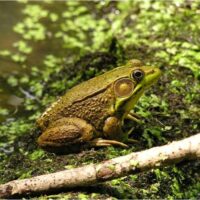 Purdue University - Extension - Forestry and Natural Resources
Purdue University - Extension - Forestry and Natural Resources
Got Nature? Blog
 Question: My husband and I love to build wildlife habitat areas and have built a large pond with a strategic filtering system in the pond. We had to place a net five to six feet up to keep leaves and acorns out of the filtering system and now the frogs are jumping on the net. One specialist said they are trying to get to the woods to hibernate for winter and one shared that they can stay in the pond as long as it doesn’t freeze. Which answer is correct?
Question: My husband and I love to build wildlife habitat areas and have built a large pond with a strategic filtering system in the pond. We had to place a net five to six feet up to keep leaves and acorns out of the filtering system and now the frogs are jumping on the net. One specialist said they are trying to get to the woods to hibernate for winter and one shared that they can stay in the pond as long as it doesn’t freeze. Which answer is correct?
Answer: Both of your answers could be correct. The following is from Michael Lannoo (2005) Amphibian Declines: The Conservation Status of United States Species. In summary, adults will hibernate in both water and on land, although underwater seems to be the most common site. The key is having available oxygen. However, hibernating amphibians when hibernating have extremely low oxygen requirements. So much so that most species get enough O2 from absorption through specialized patches of skin.
- Seasonal Migrations. Green frogs probably do not migrate en masse to breeding sites. Lamoureux and Madison (1999) tracked 23 green frogs and found that they made extensive movements in late fall away from summer breeding ponds to areas of flowing water in streams and seeps. They suggested that flowing water is used because it remains unfrozen and provides adequate oxygen.
- J. Torpor (Hibernation). Green frog tadpoles will typically, but not always, overwinter for 1 yr prior to metamorphosing the following spring (Martof, 1952; Richmond, 1964; Vogt, 1981). While overwintering, and despite cold temperatures, tadpoles remain active and likely feed (Getz, 1958). Tadpoles probably remain active and grow during the winter in Louisiana but do not transform until warm weather (Dundee and Rossman, 1989). In Maine, they remain under silt and dead vegetation during the winter (Hunter et al., 1999). Both tadpoles and adults require aquatic sites that do not completely freeze and that also maintain enough oxygen during the winter (Oldfield and Moriarty, 1994).
Green frog adults typically overwinter in water (Dickerson, 1906; Walker, 1946; Pope, 1947; Wright and Wright, 1949; Harding and Holman, 1999) but will occasionally overwinter on land (Bohnsack, 1951). The frog followed by Bohnsack (1951) was found beneath 5 cm (2 in) of compact leaf litter in an oak-hickory forest near Pickney, Michigan. Lannoo et al. (1998) cites an instance where a large number (25, including 4 gravid females) of green frogs were caught on land near a wetland during a cold snap in northern Wisconsin. Minton (1972) notes that adults near Indianapolis, Indiana, seek cover from early December to early March and that juveniles emerge earlier in the season than do adults. In Maine, green frogs hibernate either underwater or underground from October–March (Hunter et al., 1999). In Ohio, several hibernating individuals have been found in springs and in masses of leaves and aquatic vegetation on the bottom of small ponds (Walker, 1946).
Resources:
Mythbusters, Got Nature? Blog, Purdue Extension – Forestry and Natural Resources
Frogs and Toads of Indiana, The Education Store, Purdue Extension resource center
Appreciating Reptiles and Amphibians in Nature, The Education Store
Forestry Management for Reptiles and Amphibians: A Technical Guide for the Midwest, The Education Store
The Nature of Teaching, Unit 3: Reptiles, Amphibians, and the Scientific Method, The Education Store
Frogs and Toads of Indiana, The Education Store
Snakes and Lizards of Indiana, The Education Store
Ask the Expert: Turtles and Snakes video, Got Nature? post
Brian MacGowan, Wildlife Extension Specialist
Purdue University, Department of Forestry and Natural Resources

Recent Posts
- Report Spotted Lanternfly – Purdue Landscape Report
Posted: April 10, 2024 in Alert, Forestry, Invasive Insects, Plants, Wildlife, Woodlands - Declining Pines of the White Variety – Purdue Landscape Report
Posted: in Alert, Disease, Forestry, Plants, Wildlife, Woodlands - Are you seeing nests of our state endangered swan? – Wild Bulletin
Posted: April 9, 2024 in Alert, Forestry, How To, Wildlife - Cicadas in Spring! – Purdue Landscape Report
Posted: in Forestry, Plants, Safety, Wildlife - New Deer Impact Toolbox
Posted: April 7, 2024 in Forestry, Land Use, Plants, Publication, Safety, Wildlife, Woodlands - 2024-25 Fishing Guide now available – Wild Bulletin
Posted: April 4, 2024 in Alert, Aquaculture/Fish, Aquatic/Aquaculture Resources, How To, Ponds, Wildlife - Help Research Chronic Wasting Disease – Wild Bulletin
Posted: April 3, 2024 in Disease, Forestry, How To, Safety, Wildlife, Woodlands - Indiana Reptiles and Amphibians – IFWOA Webinar
Posted: April 1, 2024 in Forestry, How To, Webinar, Wildlife, Woodlands - Birding through the Seasons – IFWOA Webinar
Posted: in Forestry, How To, Webinar, Wildlife, Woodlands - Look Out for Invasive Carp in Your Bait Bucket – Wild Bulletin
Posted: March 31, 2024 in Alert, Aquaculture/Fish, Aquatic/Aquaculture Resources, Invasive Animal Species, Wildlife
Archives
Categories
- Alert
- Aquaculture/Fish
- Aquatic/Aquaculture Resources
- Ask the Expert
- Christmas Trees
- Community Development
- Disease
- Drought
- Forestry
- Forests and Street Trees
- Gardening
- Got Nature for Kids
- Great Lakes
- How To
- Invasive Animal Species
- Invasive Insects
- Invasive Plant Species
- Land Use
- Natural Resource Planning
- Nature of Teaching
- Plants
- Podcasts
- Ponds
- Publication
- Safety
- Timber Marketing
- Uncategorized
- Urban Forestry
- Webinar
- Wildlife
- Wood Products/Manufacturing
- Woodland Management Moment
- Woodlands